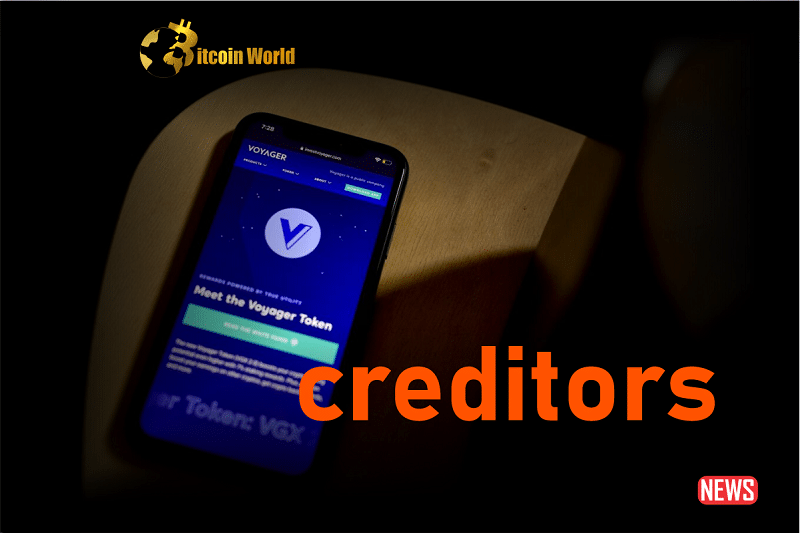Good news for Voyager Digital creditors! After a rollercoaster bankruptcy process, it looks like there’s finally light at the end of the tunnel. According to the official committee representing unsecured creditors (UCC), the wheels are in motion to start returning funds to those who had money stuck on the platform. Let’s dive into the latest developments and what you need to know.
When Will Voyager Creditors Get Their Money Back?
That’s the million-dollar question, isn’t it? The Voyager UCC recently tweeted that initial distributions could begin within the next few weeks. While they emphasize it’s a hopeful estimate, it’s a significant step forward after a long and uncertain period.
What Happened with the Binance.US Deal?
You might remember Binance.US initially stepping in to acquire Voyager’s assets for a hefty $1.02 billion. This was seen as a promising route for creditors to recover their funds. However, citing the increasingly complex regulatory landscape in the United States, Binance.US unfortunately backed out of the agreement. This news understandably caused disappointment and raised questions about the future of the repayment process.
The Self-Liquidation Plan: A Silver Lining?
Thankfully, Voyager had a backup plan in place. Think of it as an emergency exit! Their restructuring plan included a “toggle option” that allows for self-liquidation if the Binance.US deal fell apart. What does this mean for creditors? It means Voyager can now directly provide access to the cash and cryptocurrency held on its platform. This bypasses the need for a third-party acquisition and potentially speeds up the return of funds.
What Are the Benefits of Self-Liquidation?
- Direct Access: Creditors can potentially access their funds directly through the Voyager platform.
- Faster Timeline: Without the complexities of an acquisition, the liquidation process could be quicker.
- Clarity: The process becomes more straightforward, focusing on distributing existing assets.
What Are the Challenges?
- Potential Delays: While faster in theory, legal and administrative hurdles can still cause delays.
- Asset Valuation: The value of cryptocurrency assets can fluctuate, impacting the final amount creditors receive.
- Legal Objections: The liquidation plan is subject to court approval, and objections could arise.
What’s Next in the Legal Process?
Voyager now needs to officially file its liquidation plans with the U.S. Bankruptcy Court for the Southern District of New York. This is a crucial step that sets the legal framework for the distribution of assets.
Key Steps and Timeline:
| Stage | Description | Timeline |
|---|---|---|
| Filing Liquidation Plans | Voyager submits its plan to the bankruptcy court. | Imminent |
| Objection Period | Parties have 10 days to raise concerns about the plan. | Following the filing |
| Plan Effectiveness | If no objections are raised, the proposal becomes “effective.” | Potentially within 10 days of filing |
| Court Hearing | A hearing will be held to address any filed objections. | Following the objection period |
| Implementation | If approved, the liquidation plan will be put into action. | Following court approval |
What About the Creditors’ Reaction to the Binance.US Withdrawal?
Understandably, the Voyager UCC expressed their disappointment with Binance.US’s decision. They are actively exploring potential legal claims against the exchange for their change of heart. This highlights the frustration and the desire to ensure all avenues for maximizing creditor recovery are explored.
Did Creditors Approve the Initial Reorganization Plan?
Interestingly, a significant majority (97%) of the 61,300 Voyager users who voted on the reorganization proposal were in favor. At the time of the vote, the assumption was that Binance.US would be acquiring the assets. This demonstrates the strong desire among creditors to find a resolution and recover their funds, regardless of the specific mechanism.
Key Takeaways for Voyager Creditors:
- Keep an eye out for official communications from Voyager and the UCC.
- Be prepared for potential updates and adjustments to the timeline.
- Understand that the self-liquidation process is now the primary path for fund recovery.
- The legal process still needs to unfold, so patience is key.
Looking Ahead: What Does This Mean for the Future?
While the collapse of the Binance.US deal was a setback, the activation of the self-liquidation plan offers a glimmer of hope for Voyager creditors. The coming weeks will be crucial as the liquidation plans are filed and the court process moves forward. The situation underscores the complexities and risks associated with cryptocurrency investments and the importance of regulatory clarity in the digital asset space. For now, the focus is on ensuring a smooth and efficient return of funds to those affected by Voyager’s bankruptcy.
Disclaimer: The information provided is not trading advice, Bitcoinworld.co.in holds no liability for any investments made based on the information provided on this page. We strongly recommend independent research and/or consultation with a qualified professional before making any investment decisions.


